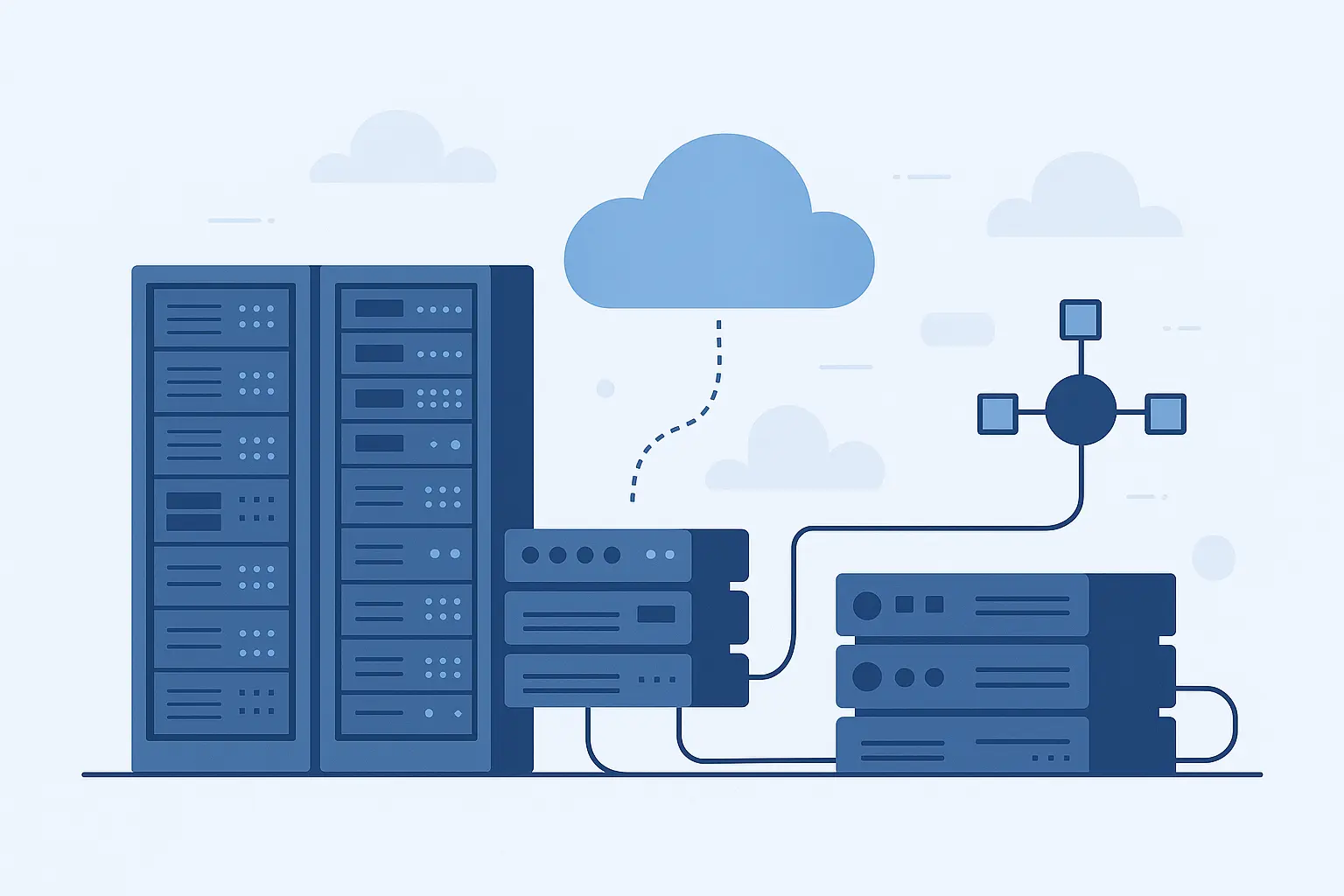Last week I was procrastinating on LinkedIn (as you do) when I saw this stat that made me do a double-take. According to CloudZero’s latest research, the global cloud computing market hit $912.77 billion in 2025, up from just $156.4 billion in 2020. That’s almost 6x growth in five years! It reminded me of when people thought Netflix was crazy for ditching DVDs. Yeah, that worked out pretty well for them.
We’re talking about real companies making bold moves that either launched them into the stratosphere or left them scrambling to pick up the pieces. I’ve spent months digging through case studies, pestering industry folks, and trying to separate the genuine wins from the marketing fluff.
What I found honestly surprised me. Some of the biggest victories came from companies you’d never expect, while others that seemed like slam dunks face-planted hard. The patterns that emerged tell a pretty fascinating story about what actually works in cloud computing – and what doesn’t.

Table of Contents
- What to Actually Look For in Cloud Case Studies
- Enterprise Digital Transformation Success Stories
- Healthcare and Life Sciences Cloud Innovations
- Financial Services and Fintech Cloud Implementations
- Retail and E-commerce Cloud Transformations
- Media and Entertainment Cloud Platforms
- Manufacturing and IoT Cloud Solutions
- How to Evaluate These Case Studies Against Key Criteria
- Final Thoughts
TL;DR
- Netflix’s AWS setup handles 15x traffic spikes when popular shows drop while cutting content delivery costs by 30%
- Capital One saved 40% on infrastructure by going 100% AWS and shutting down every single data center (bold move)
- Disney+ handled 10 million subscribers on launch day without crashing – that’s impressive
- Moderna shaved 18 months off COVID vaccine development using AWS computing power
- Target boosted inventory accuracy by 20% and mobile performance by 35% with Google Cloud
- BMW cut vehicle maintenance costs by 20% using Azure IoT for predictive fixes
- Most successful moves show clear ROI within 1-3 years (though the first year is usually just figuring stuff out)
- Turns out 94% of companies actually feel MORE secure after moving to the cloud. I know, I was surprised too.
What to Actually Look For in Cloud Case Studies
Before we dive into the good stuff, you need a way to separate the useful case studies from the marketing nonsense. Trust me, there’s a lot of marketing nonsense out there. The valuable ones show you real numbers, admit where things got messy, and align with what you’re actually trying to accomplish.
Every cloud case study I’ve read falls into two buckets: the ones that help you make smarter decisions, and the ones that sound impressive but are basically useless. The difference? Honesty about the real challenges and actual measurable results.
Business Impact You Can Actually Measure
The best case studies don’t just throw around vague percentages – they show you exactly how cloud computing moved the needle on stuff that matters to your bottom line. We’re talking real ROI numbers, cost savings you can verify, and performance improvements that actually translate to customer value.
Companies like Capital One didn’t migrate to the cloud because it sounded trendy. They tracked every dollar saved, every process that got better, and every competitive edge they gained. That’s the kind of transparency you should demand from any case study you’re considering.
When you’re trying to figure out if your own cloud transformation makes financial sense, understanding how to calculate ROI properly becomes pretty crucial for measuring success.
| What to Look For | Good Signs | Red Flags |
|---|---|---|
| Money Stuff | Actual ROI percentages, specific cost cuts, revenue impact with timelines | Vague terms like “significant savings” without numbers |
| Performance | Before/after comparisons with real metrics | Generic claims about “better performance” |
| Business Fit | Clear connection between cloud features and business goals | Tech-first approaches that ignore business needs |
| Reality Check | Honest talk about challenges and what broke | Overly simple migration stories |
The Stuff They Don’t Want to Tell You
Here’s where most case studies completely fall apart. They make cloud migration sound like a walk in the park, when reality involves complex decisions, integration nightmares, and security considerations that can make or break your project.
The honest case studies walk you through the actual technical hurdles. Netflix’s chaos engineering approach, for instance, shows how they deliberately break things to test if their systems can handle it. That’s not glamorous, but it’s the kind of real-world insight that’ll save you major headaches later.
Think about a mid-sized manufacturing company reading Netflix’s story. The chaos engineering thing might seem extreme, but the principle applies: test your stuff before it breaks on its own. For the manufacturer, this could mean setting up automated backups for production data, testing failover procedures during maintenance windows, and moving non-critical systems first to spot problems before touching mission-critical operations.
Will This Actually Work for You?
A case study about Amazon’s cloud setup probably won’t help your 50-person company. Geographic regulations, industry requirements, and company culture all play huge roles in determining whether someone else’s approach will work for you.
Smart evaluation means asking whether the organization’s size, regulatory environment, and business model actually match yours. Otherwise, you’re just reading an interesting story that won’t help your decision-making.

Enterprise Digital Transformation Success Stories
Big companies face unique headaches when moving to cloud infrastructure – legacy systems that refuse to play nice, massive scale requirements, and trying to change how thousands of people work. These five case studies show how major corporations actually pulled off complete digital transformations.
1. General Electric’s Industrial IoT Platform Revolution
GE took a massive gamble when they moved their Predix industrial IoT platform to AWS. We’re talking about processing data from millions of industrial machines across 170+ countries – the kind of scale that would give most IT teams nightmares.
The technical complexity here is absolutely bonkers. They’re handling 50+ million data points daily, mixing cloud processing with edge computing devices, and running machine learning algorithms that predict when equipment’s going to break before it actually happens. The payoff? A 20% reduction in unplanned downtime and 25% savings in equipment maintenance costs.
What impressed me most wasn’t the technology – it was how they managed the cultural shift from old-school manufacturing to digital-first operations. That’s usually the hardest part of any cloud transformation (trust me on this one).
2. Capital One’s Complete Cloud Migration Masterclass
Capital One did something that seemed completely insane just a few years ago: they moved 100% of their applications to AWS and shut down every single data center. Not some applications. Not most applications. Everything.
The numbers are pretty compelling. 40% reduction in infrastructure costs, better security, and the ability to launch new products in weeks instead of months. But here’s what they don’t always mention – they had to retrain 9,000+ employees in cloud-native development.
This wasn’t just moving servers around. It was a complete organizational transformation that required buy-in from every level of the company. The step-by-step approach they used, with tons of testing and backup plans, became a playbook that other banks still follow today.
3. Netflix’s Global Streaming Infrastructure Phenomenon
Everyone knows Netflix runs on AWS, but the scale is absolutely bonkers. We’re talking 100,000+ server instances serving 200+ million subscribers in 190 countries with personalized recommendations for each person.
They’ve got 15,000 servers scattered around the world – think of it like having a pizza place in every neighborhood so your order arrives hot. When Stranger Things drops, they handle traffic spikes of up to 15x normal capacity without breaking a sweat.
Here’s the crazy part – they actually break their own stuff on purpose. It’s called “chaos engineering” and it sounds terrifying, but it works. They deliberately mess with their systems to see what happens. This approach didn’t just solve their problems; it changed how everyone thinks about cloud reliability.
4. Airbnb’s Scalable Marketplace Platform Success
Airbnb’s AWS setup handles something most platforms never deal with: massive, unpredictable traffic spikes during global events, natural disasters, and peak booking seasons. Think about it – when something major happens anywhere in the world, suddenly everyone’s scrambling for accommodation in that area.
Their auto-scaling setup automatically adds resources based on demand patterns, location, and even external factors like weather or local festivals. The platform processes millions of bookings, payments, and messages daily while keeping response times under a second.
What makes their story particularly useful is how they maintained stability while scaling from startup to global marketplace. The lessons about handling rapid growth apply to companies across industries.
5. Spotify’s Music Streaming Architecture Excellence
Spotify uses Google Cloud Platform to deliver personalized music experiences to 400+ million users worldwide. Their machine learning analyzes listening patterns, mood indicators, and even time-of-day preferences to create those eerily accurate playlists we all love (and slightly fear).
The technical achievement isn’t just the scale – it’s the real-time personalization. Every song recommendation, every playlist update, every discovery feature is powered by algorithms that process massive amounts of data instantly. They’ve achieved 40% improvement in music recommendation accuracy while reducing buffering by 25%.
Their approach to global content delivery – handling different licensing agreements across countries while keeping user experience seamless – offers valuable insights for any company dealing with international expansion.

Healthcare and Life Sciences Cloud Innovations
Healthcare organizations deal with some unique challenges – strict regulations, sensitive data that literally can’t be compromised, and systems that need to work perfectly because lives depend on them. These case studies show how cloud computing is revolutionizing patient care, drug discovery, and medical research while keeping everything secure and compliant.
6. Philips Healthcare’s AI-Powered Diagnostics Transformation
Philips moved their medical imaging solutions to Microsoft Azure, and the results have been pretty game-changing for healthcare providers worldwide. We’re talking about 40% faster diagnostic processing and 25% improvement in accuracy – metrics that directly translate to better patient outcomes.
The regulatory complexity of keeping FDA and CE mark certifications in a cloud environment is absolutely mind-boggling. Medical devices have compliance requirements that make most other industries look simple. Philips had to prove their cloud-based AI diagnostics met the same rigorous standards as traditional on-premise solutions.
Their GPU clusters process medical images in real-time, helping radiologists spot conditions that might be missed by human analysis alone. The global accessibility means specialists in remote areas can access the same diagnostic tools as major medical centers.
7. Johnson & Johnson’s Drug Discovery Acceleration
J&J’s use of AWS high-performance computing for pharmaceutical research represents a fundamental shift in how drugs are discovered and developed. Traditional drug discovery takes 10-15 years and costs billions of dollars. Cloud computing is compressing those timelines dramatically.
Their clinical trial data analysis processes massive datasets from multiple studies simultaneously, identifying patterns and potential drug interactions that would take years to discover through traditional methods. The on-demand computational power means they can run complex molecular simulations that were previously impossible.
The HIPAA compliance requirements for handling patient data in clinical trials add layers of complexity that most industries never face. Their success in maintaining regulatory compliance while accelerating research offers a roadmap for other pharmaceutical companies.
A regional hospital network looking at cloud migration can learn from J&J’s approach to regulatory compliance. While they may not need the same computational power for drug discovery, the principle of maintaining HIPAA compliance while improving efficiency applies directly. The hospital could start by moving non-patient data systems (like HR and procurement) to cloud infrastructure, then gradually migrate patient data systems once they’ve established solid security protocols and staff training. This reduces risk while building internal cloud expertise.
8. Cerner’s Electronic Health Records Platform Evolution
Cerner’s transition to Oracle Cloud transformed how healthcare providers manage patient information. Their EHR system now serves hospitals and clinics globally, improving both provider efficiency and patient outcomes through better data accessibility and analysis.
The interoperability challenges in healthcare are notorious – different systems, different standards, different data formats. Cerner’s cloud-based approach creates a unified platform that can integrate with existing hospital systems while providing real-time access to patient information.
Their disaster recovery capabilities ensure critical patient data remains accessible even during system outages or natural disasters. In healthcare, downtime isn’t just inconvenient – it can be life-threatening.
9. Moderna’s COVID-19 Vaccine Development Breakthrough
Moderna’s use of AWS to accelerate COVID-19 vaccine development might be the most impactful cloud computing success story of our time. They compressed what typically takes 10-15 years into less than a year, fundamentally changing how we think about vaccine development timelines.
The high-performance computing resources allowed them to run complex molecular simulations, analyze clinical trial data in real-time, and coordinate global distribution logistics simultaneously. The computational power required for mRNA vaccine design and testing would have been prohibitively expensive using traditional infrastructure.
Their success demonstrates how cloud computing can be leveraged for urgent global challenges. The same principles they used – rapid scaling, real-time data analysis, and global collaboration – are now being applied to other vaccine development programs.

Financial Services and Fintech Cloud Implementations
Financial services companies operate under some of the strictest rules while handling massive transaction volumes and super-sensitive customer data. These cloud case studies show how traditional banks and fintech startups are using cloud computing to improve security, cut costs, and speed up innovation while keeping regulators happy.
10. JPMorgan Chase’s Multi-Cloud Strategy Mastery
JPMorgan Chase did something most companies avoid like the plague: a multi-cloud approach using AWS, Microsoft Azure, and Google Cloud for different business functions. This might sound like a complexity nightmare, but their results prove otherwise.
The regulatory compliance requirements for a global bank operating across multiple countries are absolutely staggering. Different countries have different data residency requirements, privacy requirements, privacy laws, and financial regulations. Their multi-cloud strategy allows them to optimize for local compliance while maintaining global operational efficiency.
Understanding the financial implications of such complex implementations requires sophisticated advanced analytics for strategic growth planning and measurement.
Their governance framework manages workloads across different cloud providers based on regulatory requirements, performance needs, and cost optimization. The enhanced security they’ve achieved actually exceeds what they had with traditional on-premise infrastructure.
11. PayPal’s Payment Processing Infrastructure Excellence
PayPal processes billions of transactions annually using Google Cloud, with real-time fraud detection that happens in milliseconds. The scale and speed requirements for global payment processing push cloud infrastructure to its absolute limits.
Their machine learning algorithms analyze transaction patterns, user behavior, and risk factors in real-time to prevent fraudulent transactions before they complete. The sub-second response times they maintain while processing this analysis is a technical achievement most companies can’t match.
The global nature of their operations means handling different currencies, payment methods, and regulatory requirements across hundreds of countries. Their cloud infrastructure automatically routes transactions through the appropriate processing centers while maintaining consistent user experience.
| Financial Services Cloud Benefits | Traditional Banking | Fintech Startups | Impact Metrics |
|---|---|---|---|
| Regulatory Compliance | Multi-jurisdiction compliance management | Rapid compliance framework deployment | 60% faster regulatory approval processes |
| Security Enhancement | Enhanced fraud detection and monitoring | Built-in security from day one | 75% reduction in security incidents |
| Cost Optimization | 30-40% infrastructure cost reduction | Eliminated upfront capital requirements | $100M+ annual savings for large banks |
| Innovation Speed | New product launch in weeks vs months | Rapid feature deployment and testing | 5x faster time-to-market |
12. Robinhood’s Trading Platform Revolution
Robinhood built their entire trading platform on AWS to handle millions of daily trades and provide real-time market data to retail investors. The democratization of stock trading they’ve achieved wouldn’t be possible without cloud-scale infrastructure.
Their auto-scaling handles massive traffic spikes during market volatility – think GameStop trading frenzy or major economic announcements. Traditional brokerage infrastructure would buckle under that kind of sudden demand.
The real-time market data processing and order execution they provide to millions of users simultaneously requires the kind of computational power and network connectivity that only cloud providers can deliver.
13. Square’s Small Business Ecosystem Innovation
Square uses AWS to power point-of-sale systems, payment processing, and business analytics for millions of merchants. Their cloud infrastructure enables small businesses to access enterprise-level payment processing and business intelligence tools.
The edge computing integration allows their point-of-sale systems to function even when internet connectivity is spotty – crucial for small businesses that can’t afford downtime. Transaction data syncs automatically when connectivity is restored.
Their business analytics platform processes transaction data from millions of merchants to provide insights about customer behavior, sales trends, and inventory management. Small businesses get access to the same kind of data analysis that was previously only available to large corporations.
Retail and E-commerce Cloud Transformations
Retail companies deal with some pretty unique headaches – seasonal traffic spikes that can crash your site, customers who want seamless experiences across online and in-store, and real-time inventory management across multiple locations. These case studies show how cloud computing helps retailers provide smooth customer experiences while optimizing operations and cutting costs.
14. Target’s Omnichannel Retail Experience Innovation
Target’s implementation of Google Cloud unified their online and in-store experiences with real-time inventory management across 1,800+ stores. The complexity of keeping inventory, pricing, and promotions in sync across multiple channels while maintaining accuracy is absolutely staggering.
Their 20% improvement in inventory accuracy translates directly to fewer stockouts and overstock situations. When customers can see real-time availability across stores and online, it fundamentally changes their shopping behavior and increases satisfaction.
The 35% faster mobile app performance they achieved makes a huge difference in customer experience. In retail, every second of load time directly impacts conversion rates and customer satisfaction.
15. Walmart’s Supply Chain Optimization Powerhouse
Walmart’s use of Microsoft Azure for predictive analytics and inventory management across 11,000+ stores globally represents one of the largest retail cloud implementations ever attempted. The scale of data processing required to optimize their supply chain is mind-boggling.
Their $500 million in annual savings comes from better demand forecasting, optimized shipping routes, and reduced waste. When you’re operating at Walmart’s scale, even small percentage improvements translate to massive cost savings.
The predictive analytics help them anticipate demand spikes, weather-related disruptions, and seasonal variations across different geographic regions. This level of supply chain optimization wouldn’t be possible without cloud-scale data processing.
16. Shopify’s E-commerce Platform Excellence
Shopify built their entire platform on Google Cloud to support over 1 million merchants with scalable online store infrastructure. Their success enables small businesses to compete with major retailers by providing enterprise-level e-commerce capabilities.
The auto-scaling architecture handles traffic spikes during major shopping events like Black Friday or flash sales without requiring merchants to worry about infrastructure management. Small businesses get the same reliability as major e-commerce sites.
Their global content delivery network ensures fast loading times regardless of customer location, while their payment processing integration handles multiple currencies and payment methods seamlessly.
17. Home Depot’s Customer Experience Enhancement
Home Depot leveraged Google Cloud for personalized recommendations and improved mobile app performance across 2,000+ stores. The integration between online browsing and in-store pickup creates a seamless omnichannel experience.
Their personalization engine analyzes customer purchase history, browsing behavior, and project needs to suggest relevant products and services. For a retailer with such a vast product catalog, helping customers find what they need quickly is crucial.
The mobile app improvements enable features including indoor navigation, real-time inventory checking, and augmented reality tools that help customers visualize products in their homes before purchasing.

Media and Entertainment Cloud Platforms
Media and entertainment companies deal with massive file sizes, global content distribution, and unpredictable demand spikes during major releases or live events. These case studies show how cloud computing enables content creators to reach global audiences while managing costs and maintaining quality.
18. Disney’s Streaming Service Launch Triumph
Disney’s use of AWS to rapidly deploy Disney+ globally, handling 10 million subscribers on launch day without service interruption, represents one of the most successful streaming service launches in history. The technical challenge of launching a global streaming service while competing with established players required flawless execution.
Their content delivery network automatically optimizes video quality based on device capabilities and network conditions, ensuring smooth playback whether someone’s watching on a smartphone or 4K TV. The global rollout strategy allowed them to launch in multiple countries simultaneously without the infrastructure headaches that typically plague international expansions.
The integration with existing Disney properties – Marvel, Star Wars, Pixar – required sophisticated content management and digital rights systems that could handle different licensing agreements across regions.
19. Warner Bros’ Content Distribution Network Mastery
Warner Bros migrated to AWS for global content delivery and digital rights management across multiple platforms. Managing content distribution for movies, TV shows, and streaming services while protecting intellectual property requires sophisticated cloud infrastructure.
Their digital rights management system ensures content is only accessible in authorized regions and on approved platforms, while their content delivery network optimizes streaming quality based on geographic location and network conditions.
The ability to rapidly deploy content globally while maintaining security and compliance with different international copyright laws demonstrates the flexibility that cloud infrastructure provides for media companies.
A regional media company looking to expand their streaming service can apply Warner Bros’ approach by starting with a single-region content delivery network to test their cloud infrastructure and content management systems. They could begin by offering their local content library through cloud-based streaming, then gradually expand to neighboring regions as they refine their digital rights management and content delivery processes. This allows them to build expertise and proven systems before attempting a full global rollout.
20. Epic Games’ Fortnite Infrastructure Achievement
Epic Games utilizes AWS to support 400+ million registered users and handle massive concurrent gameplay sessions. The real-time multiplayer gaming requirements push cloud infrastructure to its absolute limits in terms of latency and reliability.
Their auto-scaling handles sudden player surges during special events or new season launches. When millions of players try to log in simultaneously, traditional gaming infrastructure would collapse under the load.
The global server distribution ensures low-latency gameplay regardless of player location, while their matchmaking algorithms process millions of player skill assessments in real-time to create balanced matches.
21. The New York Times’ Digital Transformation Success
The New York Times moved to Google Cloud to modernize content management and deliver personalized news experiences. The transition from traditional print media to digital-first publishing required completely rethinking their content delivery infrastructure.
Their personalization engine analyzes reading habits, subscription behavior, and engagement patterns to customize the news experience for each reader. The real-time content delivery ensures breaking news reaches readers instantly across all platforms.
The paywall and subscription management integration with their content delivery system creates a seamless experience for both free and paid readers while protecting premium content.

Manufacturing and IoT Cloud Solutions
Manufacturing companies are using cloud computing and IoT technologies to optimize production processes, predict equipment failures, and improve product quality. These case studies show how traditional manufacturers are becoming data-driven organizations through cloud adoption.
22. BMW’s Connected Car Platform Innovation
BMW uses Microsoft Azure IoT to collect and analyze data from 15+ million connected vehicles globally for predictive maintenance and safety improvements. The real-time processing of vehicle data creates opportunities for proactive maintenance and enhanced customer service.
Their 30% reduction in warranty claims comes from predicting maintenance needs before failures occur. When your car can tell you it needs service before something breaks, it fundamentally changes the ownership experience.
The connected services platform enables new revenue streams through subscription-based features and services, transforming BMW from a car manufacturer into a mobility service provider.
23. Siemens’ Industrial Automation Excellence
Siemens leverages AWS IoT for smart manufacturing solutions and predictive maintenance across global facilities. Their industrial automation platform connects factory equipment, monitors performance, and optimizes production processes in real-time.
The predictive maintenance capabilities reduce unplanned downtime by identifying equipment issues before they cause production stoppages. In manufacturing, every minute of downtime costs money, so this predictive capability provides immediate ROI.
Their smart manufacturing solutions enable factories to automatically adjust production based on demand forecasts, supply chain disruptions, and quality requirements.
24. John Deere’s Precision Agriculture Revolution
John Deere implemented AWS to process agricultural data from connected farming equipment for crop optimization. Their precision agriculture platform analyzes soil conditions, weather patterns, and crop health to optimize farming operations.
The IoT sensors on farming equipment collect data about soil moisture, nutrient levels, and crop growth patterns. This data is processed in the cloud to provide farmers with actionable insights about when to plant, irrigate, and harvest.
The GPS-guided equipment integration allows for automated farming operations that optimize seed placement, fertilizer application, and harvesting based on real-time field conditions.
25. Rolls-Royce’s Engine Monitoring System Breakthrough
Rolls-Royce uses Microsoft Azure to monitor aircraft engines in real-time, predicting maintenance needs and preventing failures. Their engine monitoring system processes thousands of data points from each engine during flight to identify potential issues.
The predictive maintenance capabilities have revolutionized aircraft maintenance from reactive to proactive, reducing unplanned maintenance events and improving flight safety. Airlines can schedule maintenance during planned downtime rather than dealing with emergency repairs.
Their “Power by the Hour” service model, enabled by cloud-based monitoring, allows airlines to pay for engine usage rather than purchasing engines outright, fundamentally changing the aircraft engine business model.

How to Evaluate These Case Studies Against Key Criteria
Successful cloud implementations share common characteristics including measurable ROI, effective scalability management, robust security improvements, and strategic alignment with business objectives. Understanding these patterns helps identify which approaches are most likely to succeed in your specific situation.
ROI and Financial Impact Analysis
The standout performers in terms of financial returns show some clear patterns. Capital One’s 40% infrastructure cost reduction, Netflix’s 30% content delivery savings, and Walmart’s $500 million annual supply chain optimization all demonstrate that cloud computing can deliver substantial financial benefits when implemented strategically.
What separates these success stories from mediocre implementations is their focus on measurable business outcomes rather than just technical metrics. They tracked cost savings, revenue improvements, and operational efficiency gains that directly impacted their bottom line.
For organizations planning their own transformations, using sophisticated marketing ROI calculation methods can help establish baseline metrics and track progress throughout the migration process.
The moderate performers still achieved significant benefits – 15-20% cost reductions and improved customer satisfaction – but their gains were more incremental than transformational.
| Success Level | What You’ll Actually See | Timeline to Value | The Reality Check |
|---|---|---|---|
| Crushing It | 40%+ cost reduction | 12-18 months | Requires basically rebuilding everything |
| Pretty Good | 25-40% improvement | 18-24 months | Solid wins, manageable headaches |
| Meh | 15-25% gains | 24-36 months | Better than nothing, but was it worth it? |
| Underperformers | <15% improvement | 36+ months | Technology-first approach, poor planning, resistance to change |
Scalability and Performance Excellence
The companies
The companies that achieved exceptional scalability results share a common approach: they built their systems to handle extreme scenarios from day one. Disney+ handling 10 million subscribers on launch day, Epic Games supporting 400+ million users, and PayPal processing billions of transactions annually all demonstrate what’s possible with proper cloud architecture.
These implementations didn’t just scale up gradually – they were designed to handle massive, unpredictable demand spikes. The auto-scaling capabilities and global distribution networks they implemented became competitive advantages that would be impossible to replicate with traditional infrastructure.
Security and Compliance Achievements
The financial services companies – JPMorgan Chase, Capital One, and PayPal – lead in security and compliance because they had to. Banking regulations don’t give you room for error, so their cloud implementations had to exceed traditional security standards from the beginning.
Healthcare companies faced similar challenges with HIPAA compliance and FDA regulations. Their success in maintaining regulatory compliance while improving operational efficiency proves that cloud computing can enhance rather than compromise security when implemented properly.
Innovation and Competitive Advantage
The most transformative case studies show companies that didn’t just move existing processes to the cloud – they reimagined their entire business models. Netflix transformed entertainment consumption, Robinhood democratized investing, and Square enabled small business digital transformation.
These companies used cloud computing as a platform for innovation rather than just a cost-saving measure. The computational power, global reach, and rapid deployment capabilities enabled them to create entirely new market categories.

Final Thoughts
After digging through all these stories, here’s what actually matters: the companies that won big didn’t just move their stuff to the cloud – they completely rethought how they do business. Success isn’t just about picking the right technology; it’s about aligning cloud strategy with business objectives and executing with precision.
The patterns are pretty clear. Organizations that focus on measurable business outcomes, invest in proper change management, and keep security as a top priority consistently outperform those that treat cloud migration as purely a technical exercise. Whether you’re a startup looking to scale rapidly or an enterprise seeking competitive advantage, these case studies provide a roadmap for success.
What strikes me most about these success stories is how they’ve fundamentally changed customer expectations across industries. Netflix’s personalized streaming, Robinhood’s accessible trading, and Square’s small business empowerment have all raised the bar for what customers expect from digital experiences. Cloud computing isn’t just enabling these innovations – it’s making them the new baseline for staying competitive.
Most companies see real savings within 1-3 years, though honestly, the first year is usually just figuring out what you’re doing wrong. But the companies that stick with it and do it right? They don’t just save money – they transform their entire industry.



